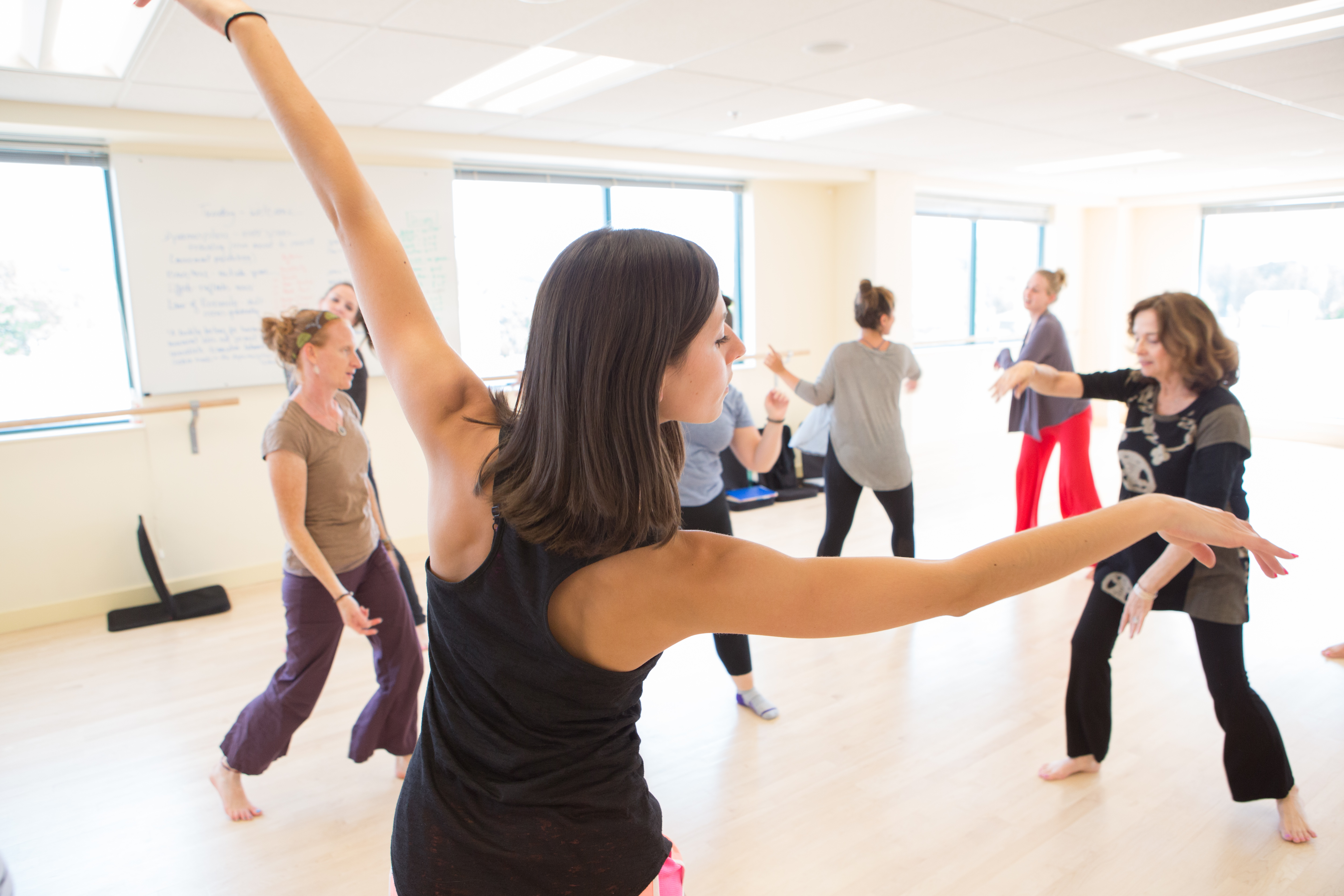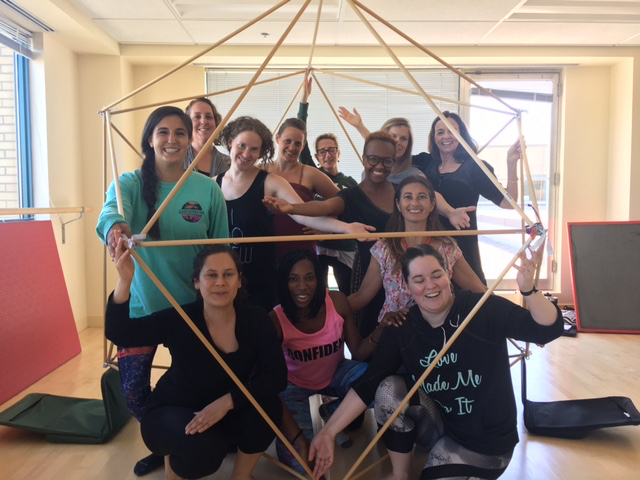Jamie Schwellenbach dreamed of becoming a dance/movement therapist, but as a parent and full-time physics teacher in Maine, she couldn’t uproot her life and move to Cambridge for a three-year, on-campus program.
Then she saw Lesley’s new hybrid low-residency program.
“I just knew that’s what I needed,” she recalls.
Schwellenbach was part of the first cohort, in 2013, of the hybrid Dance/Movement Therapy (DMT) program, which combines on-campus and online coursework. She completed her master’s degree in 2016, and now works with preschool students who have neurocognitive disorders.
“It allowed me, for the most part, to be home — to continue to work and raise my daughter,” says Schwellenbach, “but also be able to have the experience of going to graduate school with a cohort of people.”
Lesley’s Expressive Therapies division received numerous requests for a low-residency program from people like Schwellenbach, and it was clear there was a need. There are only seven approved dance therapy programs in the country, and countless populations that would benefit from the services the practitioners provide in settings that range from hospitals and clinics to residential homes and schools.
“It’s not just hybrid versus on-campus,” says Associate Professor Nancy Beardall, the DMT coordinator. “It was driven by looking at who we are serving, who are our students, how are we addressing their education as well as the needs of various clinical populations. The program provides opportunities online and in person for students to bring their own life experience and culture to the hybrid, low-residency program.”
How the program works
To participate in a successful program where master’s candidates spend the majority of their year hundreds of miles (sometimes even continents) apart, each cohort starts with an intensive three-week in-person introduction to establish a solid bond among students and faculty. The July residency also continues through the second and third summer of the program.
“We become a cohesive group and then we move online,” says Beardall, “so the students can refer back to their embodied experiences.”
For Jessica Shabazz ’18, the three weeks on campus with her cohort were transformative.
“These are people that I had just met, but they were all so supportive and comforting,” says Shabazz, a mother of three who was processing a death in her family when she arrived on campus.
Once they’re back home, students stay connected through a platform built by Lesley’s eLearning and Instructional Support team, who developed the online component of the program in collaboration with the faculty, testing various video apps that would facilitate smooth peer-to-peer and peer-to-professor communication.
That technology, which has continued to evolve since the first cohort arrived almost five years ago, allows students to post dance videos, provide video critiques and collaborate in real time.
Spreading the word
The pioneering program is generating interest in the international expressive therapies community, too.
Beardall and fellow Lesley DMT faculty members Valerie Blanc, Nancy Jo Cardillo, Shira Karman and Jennifer Wiles published a paper detailing the creation of the hybrid low-residency model that appeared in the the 50th Anniversary edition of the American Journal of Dance Therapy.
In September, Beardall, along with Lesley professors Karen Estrella, Rebecca Zarate, Raquel Stephenson and Donna Socha, and former Lesley professor Nisha Sajnani, presented their work at the European Consortium for Arts Therapies Education (ECArTE) in Krakow, Poland.
The conference theme, “Traditions in Transition,” was an apt fit for Lesley’s work and provided the opportunity to talk to educators from 33 countries about our expressive therapy disciplines — dance, music, art and drama therapy in the hybrid format.
“We saw it coming – online education— and we thought, ‘Why not be at the forefront of that? Why not be the innovators?’” recalls Estrella, an associate professor who helped develop the online programs.
“We are the only program that I know of that houses all of these specializations in one department,” she adds, noting that this structure provided a solid foundation to build the online hybrid courses.
The program also received the Innovation Award this year from the American Dance Therapy Association for creating a new way to learn dance therapy.
Our students
The hybrid program attracts a diverse group of motivated students from ages 22 to 62, who hail from Tennessee to Taiwan.
“This program attracts very self-motivated and dedicated students who feel comfortable with technology,” says Beardall, “and who know that they are going to be part of a team, but will also advocate for themselves where they are.”
The diversity of the students and the program’s rigor are what drew Victoria Ludden ’17.
“A lot of the students were older than the students on campus and had more life experience,” she recalls.
And all of the students share a passion for dance, says Beardall.
Shabazz worked full-time in hospital administration in the Washington D.C. area but never forgot her love of dance.
“I felt like I let the opportunity pass up to be a professional dancer, and this was a way for me to connect my love for dance,” Shabazz says.
Dance therapy is a second career for many of the hybrid low-residency students, such as Ludden, who spent more than a decade as a professional dancer and became interested in psychology as a religious studies major at Hunter College. She began exploring expressive therapies after attending traditional Native American ceremonies.
“I was finding new parts of myself in that healing that I wasn’t finding in traditional therapy,” says Ludden. “I wanted to learn more about it and to do it in a way that I was going to be able to bring it to other people.”
‘Try everything out’
Dance/Movement Therapy, as defined by the American Dance Therapy Association, is the “psychotherapeutic use of movement to further the emotional, cognitive, physical and social integration of the individual.” It applies to individuals and groups and helps relieve stress, improve movement awareness and expression while addressing mental and emotional challenges.
Through internships in their second and third years, students work with a variety of clients of different ages and abilities, from at-risk children to families to older adult patients in nursing homes, as they prepare to enter their career.
Beardall encourages students to work with populations they may not have considered before.
“To me the program provides a laboratory so students can explore and practice their skills,” she says.
Registered dance/movement therapists (BC-DMT) mentor and supervise students during their internships to guide them through the learning process.
In her first internship, Ludden was the only creative arts professional on staff at Community Healthlink, Inc. in Worcester, Massachusetts, where she worked with children in victim services.
“It was really great to force me to have to create,” she says. Adding, “I didn’t think I wanted to work with adolescents. I’m really glad I was thrown into it.”
Beardall is passionate about dance/movement therapy and the hybrid model as a way to expand the field, knowing it will provide a much-needed holistic therapy for people across the country and the globe.
“It’s about communication, relational connection and empowerment,” says Beardall. “DMT provides a range of movement expression providing more options to explore, relate, heal, cope and experience increased health and well being.”

